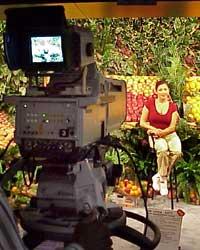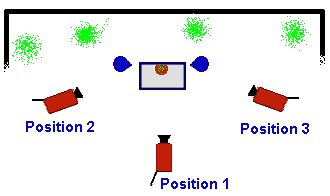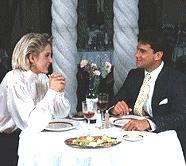|
Module 62 |
Updated: 07/19/2005 |
|
Single-Camera Production
For more than a century, "Hollywood" has been making a single film camera look like the work of several cameras working simultaneously. Like many things in Hollywood, it's actually a bit of movie magic. At first, film directors didn't have a choice; there was no way to synchronize multiple film cameras on a single scene. Although this started out as a seeming limitation, it actually turned out to be a creative advantage, an advantage that multiple-camera video productions don't share. The difference is based primarily on how film is shot. In film-style production each scene and camera angle is setup and rehearsed until the director is satisfied. Actors, lighting directors, makeup artists, audio people, etc., only need to concentrate on one scene at a time. Although it's a time-consuming and tedious process, at the same time, it provides the opportunity for maximum technical and artistic quality. |
|
You may recall from the lighting modules that the best lighting is limited to one camera angle. When people have to be lit and shot from three or four angles at the same time, as they normally are in video production, some things will inevitably be compromised. In film production many "takes" may be necessary before directors feel they have the best possible take. (Recall that a take is a short, discrete segment of action.) Some film scenes are shot dozens of times before a director is satisfied. In film, scenes are shot from different angles and at different distances, and film editors can choose from a multitude of takes. It becomes the editor's job to cut the various takes and scenes together, giving the appearance of one continuous action sequence photographed from different camera angles. With film, editing decisions are typically spread out over weeks or months-ample time to reflect, experiment, and reconsider before final decisions are made. Much in contrast, editing decisions
in live or live-on-tape video productions are done in real time on
a second-by-second and minute-by-minute basis. There is seldom the
opportunity to look back, rethink, and revise. For more film vs. tape
differences For an interesting perspective on the development of motion
picture production
Although film-style (single-camera) video production has been used in news and documentary work for decades, until recently its use in dramatic productions has been very limited. Typical made-for-TV movies are still shot on film, but in most cases that film is immediately transferred to video after processing and all subsequent postproduction work is done with the video version. With video projection in theaters for feature-length films now emerging, the move to video for all types of dramatic production can't be too far away. If nothing else, pure economics will drive the transition. Even now some feature "films" are being shot with video equipment.
One of the advantages of single-camera (film or video) dramatic production is that scenes don't have to be shot in sequence. In fact, seldom is the script's chronological sequence the most efficient shooting approach. The final sequence of scenes is determined during editing. In order of importance, the following should be considered when planning the shooting sequence of a single-camera production:
As a dramatic example let's consider just one scenario. A couple meets, falls in love, gets married, and after 20 years, starts fighting fiercely. In an effort to start over, they decide to return to the hotel room where they spent their first romantic night. Unfortunately, one of the partners finds out that the other had an affair in the room. They start arguing again, and in a final rage, one partner kills the other. (Granted, not a very pretty scenario, but it'll have to do for this example.) For scheduling efficiency it's desirable to shoot the scenes of the vicious fighting and arguing in the same hotel room and on the same day as the scenes of their first shy lovemaking. You can already see the challenge for the actors involved. Plus, while you have the lights, sound equipment, etc., set up, you can also get the shots of the affair-probably to be added in the form of a flashback-that took place in the room. Changes in the motel room will be minimal, except for aging of the walls, furnishings, etc. (We'll assume the owners didn't spend much money on upkeep.) The bigger challenge will be to age the actors appropriately. Not to worry, make-up people are pretty good at this kind of thing. In the final version of the film these scenes will be separated by other story elements. But, as you can see, it would be much more efficient if all of the motel scenes were shot at the same time. (We'll return to our unhappy couple in a moment.)
When dramatic video is shot in the single-camera style, many film conventions apply. (We introduced some of these earlier in our discussion of general video production, but here we're concentrating on the steps in single-camera production.) First we have the cover shot (called the master shot in film), which is a wide shot showing the full scene or acting area. This shot is useful to show viewers the overall geography of the scene and for bridging jumps in continuity during editing. More specifically, the master shot or cover shot is used to:
In dramatic video and film production many directors start out by shooting a scene, beginning to end, from the master shot perspective. Once this shot is filmed, the director repositions the camera for the medium shots and closeups of the various actors. For these, the actors once again repeat all their dialogue. To accommodate the new camera distances and angles these setups often require changes in lights, microphone positions, and sometimes even make-up. Obviously, all this has to involve changes that will (that should) go unnoticed when all of the takes are cut together. Some directors shoot the scenes in the opposite sequence: closeups, medium shots, and then master shot. However you do it, the series of setups associated with a scene is commonly referred to as coverage. (Remember, some terms may have different meanings in film and video, so don't be surprised if you see some of these terms used in different ways.) As an example of the scenario we've
been discussing, let's consider the restaurant scene where the man in the ill-fated
marriage originally proposed marriage to the woman. In single-camera film-style shooting the three camera positions indicated are actually one camera that is moved to each position. Although directing approaches can vary, let's look at one possibility. First, we run through the entire dialogue for the scene from
camera position #1. We can use this wide shot as a master or establishing Next, we run through the entire scene again from camera position #2 as the dialogue is repeated. From this position we can get over-the-shoulder shots or closeups. Finally, we do the same thing all over again from camera position #3. The actors must be careful to make the same moves in the same way on the same words in their dialogue. Otherwise, the words and actions in different takes will not match and that will make it very difficult to cut between the various takes. When we finish, we'll have at least three complete versions of the scene to choose from during editing. The obvious editing approach would be to use a closeup of each person as they speak. But, as we've noted, often a reaction shot is more telling. For example, it might be better to have a closeup of the woman's reaction as the man "pops the question." We would probably also want to get closeups of the ring, the wine glasses clinking together in a toast, etc.
Part of the art of directing is bringing out the best on-camera performance in actors. A good director finds an optimum point between forcing the actors to follow his or her own rigid interpretation and giving them absolute freedom to do as they wish. The optimum point between the two extremes will depend largely on the experience of the actors and the personality of the director. During read-throughs or table readings (the informal group sessions where the actors initially read through their lines) directors should carefully observe the character interpretation that actors are developing. Although the director is in charge and is responsible for getting the performance he or she envisions, directors who have limited experience with actors will want to "tread lightly" until they understand the acting process and the personality of specific actors. Directors who have taken acting classes, or who have acting experience have a definite advantage.
During rehearsals the director decides on the basic actions and business of actors. (Business refers to the secondary action associated with scenes. It would include fixing a drink, paging through a magazine, etc.) Scripts generally do not describe actor business, but it can influence camera shots, setups, and editing.
As we've noted, the single-camera, film-style approach offers many important creative advantages in dramatic production. As we will see in the next section, this approach is also valuable in shooting news and documentary pieces. But this approach is also time-consuming, and in TV production time is money. When time or budget limitations demand a faster and more efficient approach, the video producer must rely on multiple-camera production, the topic of the next section. Assigned readings: In the next section we'll take up news and documentary production. Even if you don't have an interest in news or documentary work, many of the principles outlined are important to other types of production. |

 In
contrast, in typical video dramas actors have to memorize lines for
a complete production, and they may even have to go through the whole
production without stopping. Lighting, audio, make-up, etc., have
to work for long shots and closeups, and for a variety of different
camera angles.
In
contrast, in typical video dramas actors have to memorize lines for
a complete production, and they may even have to go through the whole
production without stopping. Lighting, audio, make-up, etc., have
to work for long shots and closeups, and for a variety of different
camera angles.
 shot,
and thereafter whenever we need to reestablish the scene, cover bad shots on camera
positions #2 or #3, or just to introduce visual variety.
shot,
and thereafter whenever we need to reestablish the scene, cover bad shots on camera
positions #2 or #3, or just to introduce visual variety.